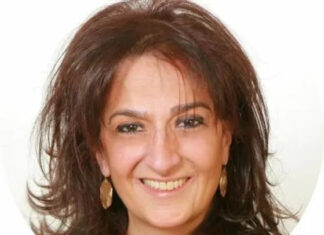DETROIT — On the wintry evening of March 5, about 75 people gathered for an educational forum at the AGBU Alex and Marie Manoogian School, in Southfield, Michigan. The format allowed for three panelists to make presentations, followed by moderators selecting written questions from the audience for the panelists.
Paul Kulhanjian opened the program and acknowledged other members of the committee that helped facilitate the event — David Terzibashian, Pam Coultis, and Hagop Alexanian. Kulhanjian introduced Ani Bogikian Kasparian, Coordinator for the Armenian Research Center, University of Michigan-Dearborn, as the MC for the program.
Kasparian introduced the first panelist, Dr. Ara Sanjian, Associate Professor of History and Director of the Armenian Research Center of the University of Michigan-Dearborn.
Sanjian received his PhD from the University of London and is the author of Turkey and Her Arab Neighbors, 1953-1958, and many scholarly articles.
His slide presentation (which included color-coded maps) focused on the “Impact on Armenians in the Arab East.” He provided background information about the “Arab Spring” which began in Tunisia when Mohamed Bouazizi, a 26-year old street vendor set himself on fire on December 17, 2010. This act became a catalyst for the Tunisian Revolution. Protests moved from Tunisia to Egypt and to other Arab countries, including Libya, Yemen, Bahrain and Syria.
In Bahrain, Syria and Yemen initial demands for reform eventually turned into communal strife among the countries’ Sunni and Shi’ite elites and their outside backers. Religious differences are not the primary cause of the conflict. The important thing in the region now is the rivalry between Iran and Saudi Arabia. The former is trying to extend its influences through the Shi’ite in Bahrain, Yemen, and Lebanon, and it is an ally of Syria (ruled by the Alwawite al-Asad family) since the Islamic Revolution of 1979. The Saudis are using the Sunni/Arab card when trying to keep Iranian influence out of all these countries, by supporting the Sunni regimes in Bahrain and Yemen, and by getting rid of the Asad regime in Syria.
According to Sanjian, possible near-future scenarios in Iraq and Syria include the following:
Existing inter-state borders will remain on paper, but the actual countries will become fragmented into federations or confederations along religious and/or ethnic lines
Existing states will formally become fragmented along religious and/or ethnic lines
Sunni Arabs will impose their rule across the Middle Eastern region over reluctant religious and/or ethnic minorities
More than one-half of the Armenians in Syria are now outside the country, while some Armenians have relocated inside Syria, particularly to the coastal region. Lebanon and Armenia provide the most immediate destinations for Armenians leaving Syria, although long-term migration is sought eventually to Canada, Australia, and Northern Europe. The Armenian community in Lebanon is not in panic, since the country is relatively calm, even if politically paralyzed.
Kasparian then introduced the second panelist – Edmond Azadian, who is director of publications for Baikar and the Armenian Mirror-Spectator (also senior editorial columnist). He has authored several books and edited more than 21 books.
“Armenia in the Midst of Turmoil” was the subject of Azadian’s presentation. He traced Armenia’s history from World War I when Armenia lost an opportunity to have a port in either Alexandretta (Iskenderun) or Trabzon — resulting in Armenia being a landlocked country — to the present.
When Armenia was absorbed into the Soviet Union, its geographic limitations were minimized — until Armenia gained its independence. For the last 25 years, Armenia has faced war for Karabagh and the earthquake while being blockaded by neighboring Turkey and Azerbaijan, resulting in ongoing depopulation.
These neighbors and Georgia have effectively choked Armenia by designing energy pipelines and railways to by-pass Armenia.
Armenia was courting the European Union — until the emergence of the new cold war with Russia seeking to ascend to its former status as a superpower — resulting in Armenia being “pulled” into Moscow centered Customs Union. According to Azadian, Russian Base No. 102 (outside Yerevan) with its recent buildup and military exercises have proven beyond doubt that Armenia will be the last one to benefit from this alliance.
He also discussed an interesting development that took place on December 23, 2015 in Moscow where a meeting took place between pro-Kurdish Democratic party leader Salahettin Demirtas and Russian Foreign Minister Sergei Lavrov about a plan to “reshape” Turkey by creating the Anatolian Confederate Republic.
Meanwhile, in the background, various treaties are being challenged, abrogated, possibly annulled. Some Armenians believe that Putin will return Ararat to Armenia. As long as the Karabagh issue is not settled with Azerbaijan, there will not be an improvement in the relationship between Armenia and Turkey.
Kasparian introduced the third speaker, Vahe Sahakyan, who is a Manoogian Postdoctoral Fellow in the Department of Near Eastern Studies, University of Michigan-Ann Arbor. His talk focused on the “Impact of the Syrian Armenians in Armenia” since 2012.
Sahakyan’s talk began by discussing the change in policies in Armenia, and then how it affects the integration of Syrian Armenians.
According to the Ministry of Diaspora of the Republic of Armenia, about 20,000 Syrian Armenians have entered Armenia since 2012, of whom 16,000 have stayed in Armenia. Sahakyan mentioned that Armenia is not open to all Syrian refugees, but more importantly, the Republic of Armenia does not view Syrian Armenians as refugees as stated at a workshop on February 24 by Hranush Hakobyan, the Minister of Diaspora. Three years ago, the minister stated “The Syrian Armenians cannot be called refugees in their homeland.” This explains why Armenia has not accepted Syrian refugees who are not of Armenian descent.
The government’s view is that Syrian Armenians are repatriates rather than refugees. According to the standards of the UN 1951 Convention on Refugees and the Republic of Armenia’s law on Refugees and Asylum, however, the Syrian Armenians could be regarded as refugees because they are unable to return to their residences due to the conflict, violence and aggression in Syria.
Sahakyan stated that the current influx of Armenians was in fact the third massive influx of ethnic Armenians. The first occurred in 1988-1992 when Armenians fled Azerbaijan; the second occurred in 2003-2004, when Armenians fled Iraq. These were recognized as refugees. In July 2012, the government of Armenia authorized the consulates in Lebanon, Syria, and Iraq to issue citizenship and passports to people of Armenian descent free of charge.
Sahakyan explained that granting refugee status to Syrian Armenians would be an extra burden to the government. Its preemptive decision to provide citizenship to the Syrian Armenians overrides the possibility of their becoming refugees.
Because the vast majority of Syrian Armenians lack refugee documents, and have been granted Armenian citizenship, they should be treated the same as other citizens of Armenia. Sahakyan’s view is that they have to be treated differently because “they are actually refugees.”
Syrian Armenians face challenges in integrating successfully in Armenian society. They need assistance in four areas: housing, employment, access to health care and education. Along with other citizens of Armenia, Syrian Armenians have free access to primary health care facilities and public schools. Students in higher education institutions in Armenia may receive tuition scholarships from the AGBU and Calouste Gulbenkian Foundation.
Not surprisingly, housing continues to be a problem. The plan to construct a district for Syrian Armenians in Ashtarak (about 15 miles from Yerevan) that would accommodate only 2000 people lacks the funding to be completed.
There are no reliable statistics about the numbers of Syrian Armenians who are employed, self-employed, or unemployed. There are about 300 small businesses owned by Syrian Armenians — contributing to the economic diversity in Yerevan — especially in the area of food service. However, these small businesses attract mostly Syrian Armenians.
While job or business opportunities are possible, the major problem is low wages. The unemployment rate is 17 percent; the poverty rate is about 33 percent. Even if employed, Syrian Armenians are not able to make enough money to support their families. This is one of the reasons they prefer to leave Armenia for third countries.
Sahakyan concluded his talk by stating that the Syrian Armenians came to Armenia with an idealized image of a homeland. Their great expectations were met with disappointment — when their homeland was unable to embrace them and meet their needs. If the intention of the government is to encourage long-term integration, much remains to be accomplished.
A brief question-and-answer session was moderated by Edward Haroutunian and Alice Nigoghosian. Haroutunian is active in the State Bar of Michigan and is a current member of the State Bar of Board of Commissioners.
Nigoghosian, formerly associate director of Wayne State University Press, now produces books as Book Publishing Consultants LLC.
An afterglow with the participants followed this informative program.
This program was sponsored by the Detroit United Committee – Armenian Assembly, ADL-Ramgavar Party, AGBU, Armenian Research Center—University of Michigan-Dearborn, CSAI, Detroit Armenian Women’s Club, Daughters of Vartan-Zabel Otyag Chapter, Knights of Vartan-Nareg Shavarshan Lodge, Tekeyan Cultural Association, Wayne State University Society of Armenian Students.
This summary of highlights from the program was prepared by Alice Nigoghosian.
The video entitled “Armenians and the Crisis in the Middle East” can be viewed via UTUBE.
Detroit Community Hosts Forum on Crisis in Middle East and Impact on Armenians
Top 5 Articles
- Trending
- Most Viewed
- Most Commented
- Valerian Markarov: Writing Russian and Being Armenian in Georgia
- US and European Aid Package to Armenia Is Not Only Cheap, It’s Dangerous
- California Armenian Legislative Caucus Foundation Announces Scholarships in Remembrance of the Armenian Genocide
- Recipe Corner: Kohar Avakian’s Cherished Family Recipe for Tutum
- Recipe Corner: Zatiki Chorek: Armenian Easter Bread
- Why I Am Grateful to Erdogan, the Dictator of Turkey
- A Political Whirlwind Engulfs Nagorno Karabakh
- Libya’s Interim Government Recognizes the Armenian Genocide Once Again
- Robert Bedrosian Marries High Tech With Ancient Armenian Manuscripts
- Aleppo Aid through St. Kevork Armenian Apostolic Church of Houston








